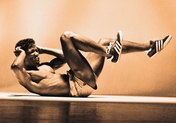 In my last post Core Training Part 1, I covered core stability, the foundation of your core. Today is going to focus on core strength... Yes what you look at in the mirror. These muscles help with your core stability of course, but the main function is to twist, bend, extend (or any combination of those motions) your trunk. This means you can't be an athlete without them. To keep things simple here is a crash course:
Core Strength is needed for weightlifting, all quick/powerful movements and body control, which are demanded of the game of football. The core is relied upon through the scope of strength exercises like squat, bench press, deadlift and overhead press. These movements require the spine to hold a firm position so the hip and shoulder joints can move with force. But also core strength is also used to twist and tackle, throw a 30yd pass and to kick that game winning 40yd field goal. Core Stability + Neurological Efficiency = Body Control Core Stability + Core Strength + Body control = Foundation for Power Production Core Strength Exercises include (but not limited to) the following: V-ups, Cable crunch, Med ball chops, Russian twists & back extensions (with or without rotation). Want to test your Core Strength? Under 16: perform 20 v-ups without letting your feet touch the ground. 16+ perform 20 v-ups with 10% of your body weight split into two dumbbells you keep in your hands. Note: make a 'V' not a 'U' so you must be sitting on your butt at the top position. Next Week Pt. 3 I'll get into Core Power Don't waist your talent, release your inner athlete by getting StrongerQuicker! Click HERE to view my training products. Written By: Coach Ryan Bishel, BA, PES Like this article? Thank me by sharing it or give it a "LIKE!"
0 Comments
 (YES) I Walk the Talk! (YES) I Walk the Talk! It's amazing that most athletes aren't taught this Basic, Easy & Amazingly helpful information that is vital to athletic success... But, at least you are reading this now ... and I tip my hat to you. (Yes I'm a country boy at heart) What is the only bone structure that connects your upper and lower body? That's right, your spine! Don't you think it would be a bright idea to protect it? (...Unless you would like a very short career, then your answer should be yes!) So let's learn about what protects and stabilizes it, your Core muscles. To keep things simple here is a crash course:
Core Stability is the foundation for quick/powerful movements and body control, which are demanded of the game of football. It is the ability to support & connect the forces from your arms and legs during all movements on the field. Got Power? Well power relies on the efficiency of your muscular effort and body control. You can have tree trunks for legs, but if your core is weak and lacks stability then you are no where near your potential and have a greater risk of injury. Core Stability allows you to Cut, Accelerate, Hit (and take a hit for that matter), Tackle & Block ...So stability training MUST be in your weekly training program no matter what position you play out there. To Amazingly Easily Understand: Core Stability + Neurological Efficiency = Body Control Body Control = Prevent Injury, Cut Quickly, Explode, Juke, Hit, Tackle, Accelerate ... Get it? Highlight reel stuff :) Core Stability Exercises include (but not limited to) the following: Planks, bridges, side bridges, glute-march bridges and stability ball stabilization exercises. Want to test your Core Stability? Time how long you can hold a plank on your elbows and toes... By my athletic standards as a Performance Coach, the minimum time should be 3min. (and yes, without arching your back and looking like a half-pipe for a skateboarder to use) Next Week Pt. 2 I'll get into Core Strength Don't waist your talent, release your inner athlete by getting StrongerQuicker! Click HERE to view my training products. Written By: Ryan Bishel, BA, PES Like this article? Thank me by sharing it or give it a "LIKE!" 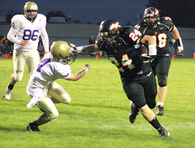 As a running back in the game of football, you very likely already have a certain amount of speed, but there are ways to develop your speed to its full potential. Of course the the dream of every back is to break into the open field and sprint it in for 6, but how do you get into the open field (besides having a great O-line)? By being shifty and agile while having vision of the cut you are going to make after the one you are already making. Yes your coaches will make you learn the different gaps to shoot but many times you need to be creative and athletic to get those extra yards! Tip 1) Develop Core Stability Your Core muscles stabilize your spine and hips... Kinda important for a guy trying to avoid guys double his weight tackling him right? I'm not just talking about ding 100 crunches a day either. I'm referring to planks, side bridges, stability ball exercises, med ball work and standing cable rotations. Tip 2) Develop Basic Plyometric Movements Plyometric exercises (targeting your lower body) will increase your agility, speed and quickness giving you the reaction time that linebackers have nightmares about. Jump rope 60min (total) every week, master power skips & hop on one leg in multiple directions (stopping at any one direction to check your balance and body position). Tip 3) Develop Foot coordination Agility ladders are your friend! When I was training a DB his senior year, who was aspiring go gain a pac-10 scholarship, there was never a training session that went by where I didn't have him use one. I confused his feet on the ladder and forced his body to learn the complicated steps. This new level of coordination and foot speed allowed him his brain to move his feet in the best position possible for the play before he even decided on where he was moving. (...Antoine Cason went on to be a 1st round NFL Draft pick and has made interceptions every year of NFL career, in his 7th season as of this article). Don't waist your talent, release your inner athlete by getting StrongerQuicker! Click HERE to view my speed products. Written By: Ryan Bishel, BA, PES Like this article? Thank me by sharing it or give it a "LIKE!" 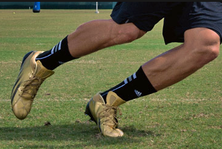 For years I have heard coaches use the term "Push" when trying to get athletes to move more explosively. "Push off your feet!" Sounds familiar right? Well that;s fine and all for average athletes, but if you really want speed, who doesn't, then you need to start replacing the word "push" with the action word of "punch." Here is why: pushing the ground away can/will make your feet spend a longer time of the ground, thus reducing speed. By using the power phrase of "punch," you will drive more force through the ground, while having your feet feel more spring-like. To feel what I am talking about, simply perform 5 reps on a jump rope saying "push" as you land then perform 5 reps saying "punch" right before your feet contact the ground. No, seriously try it! That is what every cut, acceleration and change of direction needs to feel like. One other coaching cue that is vital to this term of "punching" is to shift your center of gravity away from your heels and forward (or any other angle). So to feel this, Sprint 2 steps (from a standing position), then sprint 2 steps saying "Punch-Punch" after you first fall forward with your heels off the ground. You are now quicker! Don't waist your talent, release your inner athlete by getting StrongerQuicker! Written By: Ryan Bishel, BA, PES Like this article? Thank me by sharing it or give it a "LIKE!" Written By: Ryan Bishel, BA, PES 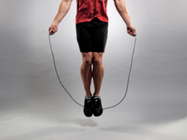 Are you still thinking in the stone age and have convinced yourself that jumping rope is just for the playground? Skipping rope naturally improves your ability to land on your balls of your feet. This is a good thing, unless you like feeling like you have lead in your feet! All movements of speed and agility include your feet rapidly bouncing off of the ground (not pushing). So by teaching yourself to jump rope like a professional boxer, you will (simultaneously) train your legs to feel "Bouncy" and less "lead-like." Quickness also comes from staying relaxed in your extremities while keeping your spine erect and your abs activated. Skipping rope will teach you to be fast while keeping relaxed. Jumps are short and quick, just like the movement of jumping rope is small and crisp. Can you take guess at what is one of the most basic forms of plyometric exercise is? .....Ok so you read the title of this article, well at least you get it now. If you have ever thought of starting plyometric workouts, first test yourself in how long and well you can jump rope for. Also, coordination is key in athletics! Every athlete needs to have the attributes of quickness, agility and of course speed. They are the differences in feeling the confidence and having the ability (for that matter) to make the big plays! Jumping rope can benefit the required muscle groups and muscle fibers for efficient execution in just about every sport and every athletic development training movement. It is not only an ideal training exercise, but it is also one that prevents injury. You will strengthen the muscle groups that support your feet, ankles and knees which in turn will reduce injury risks. Jumping rope is a great addition to your warm-up, so start it today! JUMP ROPE WARM UP EXAMPLE: 50x Regular Jumping 50x Side to side 50x Forward & backward 50x Boxer shuffle (2 on Right Ft., 2 on Left) 20x Double jumps 0:30sec - As many as you can do Written By: Ryan Bishel, BA, PES  Ok, so what does "Squeeze the Sponge" mean? Well I'm talking about "Effort." All to often I see athletes just going through the motions, which will cause a plateau in their performance. In order to progress as an athlete, all of the quick & explosive movements need to be pre-programmed into your neuromuscular system at 100% effort. Let me explain, if you perform 5 20yd sprints at 75, 80, 78, 95, 89% effort, then that is what you have pre-programmed into your system for "Game Day." You can not expect to be the quickest athlete out there if you haven't trained your body to do so on a consistent basis. We as humans are creatures of habit, I know, you have heard this before. But... We really, are. Our bodies by nature, are wired to "Program" all motions into our neuromuscular system so they become "learned." Think of every rep and movement your body makes is just the same as writing your name over and over again when you were little. Why were our parents and teachers so pushy about it... so we could one day write our name faster than say it. Well cutting on the field to change direction before your opponent beats you on the play, needs to be "Programed" just like writing your name, tying your shoes, walking, saying the alphabet, ... ok I'll stop there, but you get the point. Multiple reps a week aren't enough if you want to prevent injury and become faster than you have ever been... those reps aren't just reps, they are vital programming sessions and should be taken seriously. Every angle your joints make are very important for biomechanics & movement efficiency, so those reps, need to be Perfect Reps and Repeated Perfect Reps. Expect more from yourself, and squeeze the mental sponge.... because you have more potential than what your old self told you yesterday. So the moral of the story is ... A) "Train your body at the speed at which you want it to perform on "Game Day" and except nothing less!" B) "Train your body for perfect athletic movements, you are programming speed, not just working out!" By: Ryan Bishel, BA, PES ~~~Thank me for posting this by IMPLEMENTING IT! ~~~  Gaining inches of vertical can be challenging due to many factors. That's why you are probably asking yourself: "How do I jump higher?" "...How do I gain more inches of vertical?" Well here are 5 key factors that all contribute to an increase in vertical jump height and athletic performance. (Well "Cat-Like" Reflexes help too) #1) Warm-ups Warming up is important when playing. This is because it can stimulate the energy within our body & warm up your muscles, making it easier to propel your body upwards. Try not warming up and look at the height of your jump. Record the 1st jump and then do a 10-15min warm-up. Jump again after the warm up. You will see a difference. #2) Relative Strength Example: A 150lb athlete that squats 300lbs has more Relative Strength than a 200lb athlete that also squats 300lbs. Science says: Less mass means less gravity. It also says: Stronger muscles & Maximal Strength produce more force. Now when both are combined together, this is called Relative Strength. To propel your body up and jump higher than normal, these two must be focused on regularly. It's pretty simple really, just think of the quickest, most explosive athletes you know, they are both lean and are strong. Action: Lose body fat & get your body stronger and more powerful so in turn, you will be "Lighter relative to yourself" [Relative Strength]. Helpful exercises include: Upper Body Exercises, Abdominal Exercises, Squats, Calf Raises, Hip Flexor Exercises, Transverse abdominal/oblique exercises #3) Flexibility Do this everyday and you will increase your range of motion. Note: there are 2 mandatory types of flexibility: Dynamic (walking lunges, leg swings, etc) and Static (touching your toes, calf stretch, etc). Pre = Dynamic, Post = Static. #4) Plyometrics They improve the overall nervous system. Helpful exercises include: Jump Roping, Bounding & Ladder Drills. #5) Body Positioning & Movement Mechanics Place your hips at 30-40 degrees, your knees at 60-70 degrees, your ankles at 25-30 degrees all while swinging your arms behind you. Explode upwards using the energy from your leg muscles with a rapid upward arm swing. Note: Make sure there is a quick transition from down to up... Your muscles will store energy that will be released as you move up, helping you gain inches. By: Ryan Bishel, BA, PES No! I've been saying this my entire professional coaching career, it is the type of training you are doing combined with the proper mechanics, not all the fancy equipment. Just for reading this, you can save $ on your order by clicking on the link below:
 Ron Burgandy Making A Mistake Ron Burgandy Making A Mistake I read this article from a sport psychology resource that I have followed for years. Check it out: Does your young athlete have trouble coping with mistakes? Do your athletes check out during games because they can't let go of mistakes? In fact, 35% of sports parents we surveyed said that their young athletes struggle with letting go of mistakes. In other words, if your kids can't let go of mistakes, this can spiral into real "mental game" challenges in sports. When this spiral begins, young athletes become frustrated, lose confidence, and get angry or give up altogether. Some parents have described this syndrome as "checking out." Their kids stop caring because they are in the grips of frustration and anger. We admit that this sounds harsh, but this is the reality. In fact, some kids, like the one mentioned below, are even threatened with getting kicked off their teams! In order to be successful, your young athletes need to learn how to let go of mistakes and remain composed. If they can't stay composed, they risk not playing up to their potential. Then one mistake snowballs into more mistakes, which snowballs into the fear of more missed goals, missed putts, turnovers, lost rebounds....and more bad performances. This is what it looks like: A young basketball player begins a game with high hopes. But after a few missed shots, he stops shooting. He's afraid of missing more shots. He stops taking risks and plays very tentatively. He's not very effective, and starts to feel frustrated--even angry. Check out this Link: http://www.kidssportspsychology.com/public/department66.cfm  After so many years of meeting well over 1000+ athletes I have noticed some common "ingredients" that the most successful ones possess. Do you have at least 1 of these ... or better yet, all 3? 1) A commitment to their priorities. 2) A burning desire to achieve their goals. 3) A willingness to learn & to be taught. Here is what I mean by a commitment to their priorities. Once an athlete picks a goal to achieve, there must be an adjustment of priorities. We all have different life balances and things going on in our life so an athlete must take the time to sit down and write out a list of priorities and stick to it. All to often I see athletes "change on the fly" (so to speak) due to things like: their friends influence, entertainment distractions, poor decisions on food intake, etc. For example: If your goal is to become a starter on your team, and it's the 3rd priority behind family and getting a 4.0+ in school, then you should never let your social life get in the way of your training schedule. That being said, both the type of athletic development training you are getting and the volume of it will need to be improved. The next point I'm making about having a burning desire to achieve goals that are set is very important. This is the nucleus of the 3 ingredients. The reason being that this is "willpower" and that has to come from within, not taught. Coaching and teaching it can only bring perspective the the situation. If you truly, deeply, down in your soul want to decrease your 40yd dash time then you will... simple as that. If you don't then other distractions will de-rail you from your mission at hand. The third ingredient of having a willingness to learn & to be taught is often overlooked. Here is what I mean, you can't bring your ego to the table every time. If you knew everything there is to know and your body is programed neuromuscularly to be at optimal performance, then you would be at your goal and wouldn't be reading this article. Blunt, yes, but it's the truth. The mental toughness of an athlete is either their best friend or their enemy. Part of being mentally sound is having your "student" hat on at all times around both your training staff & your coaching staff. You will make the progressive strides you are looking for even if you just put that student hat on 50% more of the time... so could you image if you always did? I'd like to also add that having quality coaches around your is vital to this athletic success formula. To help you get moving forward, I want you to post in the comment section below, your "Declaration of Action" that your are going to start taking as of today. I'm saying this because you don't possess the magical ability to rewind the clock ... all you can say is either: I should have... I could have... or I did. Training Videos ... Take a look! |
Details
AuthorRyan Bishel, BA, PES has been coaching athletes since 1999. Numerous athletes have competed in NCAA athletics and professional sports. Archives
October 2014
Categories |
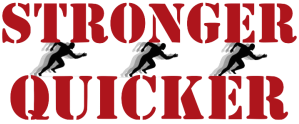
 RSS Feed
RSS Feed
